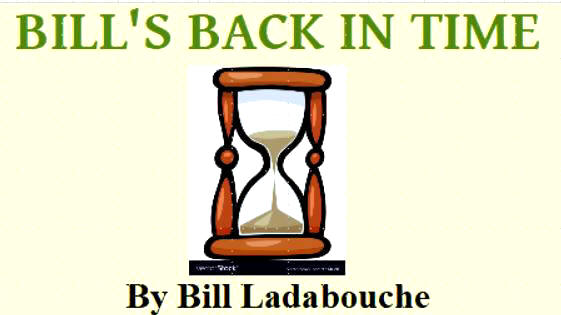
BILL'S
[Somewhat] WEEKLY COLUMN/BLOG PAGE

AYUP THEY GAVE IT A HELLUVA TRY
There had been a brief run of around three years of post WWII stock car racing by 1951. Those slamming around with cars with roofs were not really raising a lot of concern [albeit while, in fact, raising a lot of dust]. However, there were a number of factions of persons who, for their reasons, were determined to put a stop to that ridiculous jalopy business, once and for all. It was bad enough that the hooligans raced their hot rods up and down street and roads at night; but now they seemed to have permission to do that awful speeding !!!!
Firstly, there were the strightlaced Christian folks who simply could not abide that noisy, raucous car racin' on the sabbath. It “warn't right” havin' that noise and dust; and, what's worse those “people” wasn't goin' to church neither. If the North Puckerbrush Considated Methodist Church was REALLY lucky, a race track would spring up in close proximity to their chapel the Rev. Billy Bob could compete with roaring motors as he called down the wrath of God on whoever or whatever was sinning.
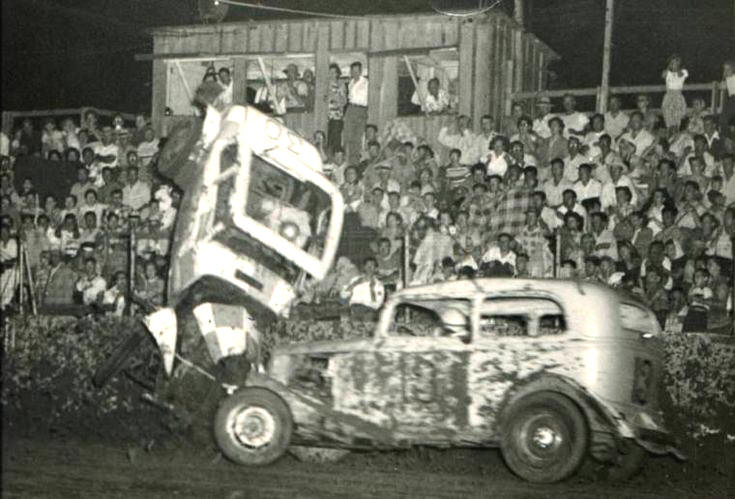
Pinterest Image
Them gawd – danged maniacs fellers in
them heaps is ruinin'
the Sabbath ! Below - In the North Puckerbrush Considated
Methodist Church the preacher had to yell louder than normal.

Artfabrik.com
Secondly, there was the law and order bunch. They knew every negative law that could possibly limit ones fun or one's right to do something they didn't approve of. After all, 'twas the sabbath and you were 'sposta rest on the sabbath. My lord, what would be next ? Gambling !!!? Didn't everyone notice those young hooligans who had come back from WWII, the big one, wanting to continue to mess around with machinery like they learned in the service ? That there hellin' around at night with their hot rods was really bothering this group.
The third group was genuinely concerned about the apparent lack of safety connected to the burgeoning sport of auto racing. Perhaps, they had already watched sprinters or midgets perform at the local county fair; and moreover, they may have seen a serious or even grisly accident seeing as those old horse tracks were seldom suitable for speeding cars. This third group was a little easier to stomach in that they didn't really resent all those young fellers havin' a little fun; but, it seemed like many of them were trying to maim themselves.
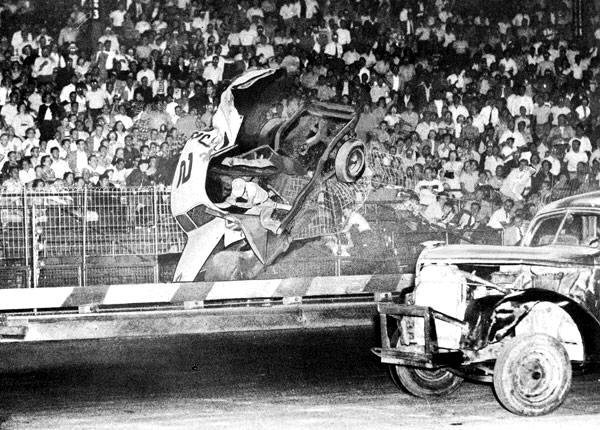
SpeedAge Photo via Lew Boyd
But it seemed like many of them were
trying to maim themselves.
Below – How could anybody get hurt in a nice car like this ? This
is a car from the old West Perth, NY track.
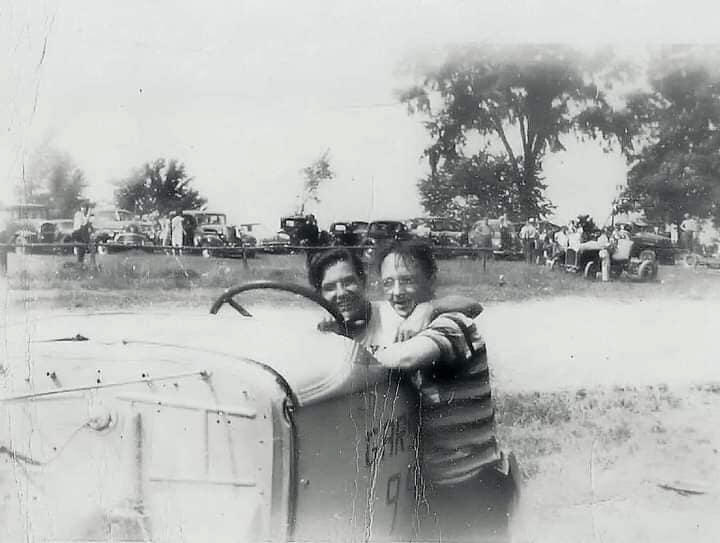
From Dan Ody
By 1950 and 1951, the feces had really hit the fan blade in both New York state and the neighboring state of Vermont. It would not seem like the size of the latter state would constrain comparison, but Vermont had more race tracks per capita than did the Empire State. Vermont had at least 24 race tracks operating simultaneously in the earliest years of the 1950's. New York had a ton of tracks, as well and they had the hairier form of auto racing – the roadster.
I think it is fair to say, Vermont objectors fell mostly into the first two groups while New Yorkers could fit into all three categories of complainers. Whereas a little bit of roadster racing did make it to Fair Haven, VT's Fairmont Park Motor Speedway and the Stateline Speedway that sat straddling the state borders near North Bennington, VT and Cambridge NY – Vermont didn't have that much while New York had a significant number of roadster tracks.
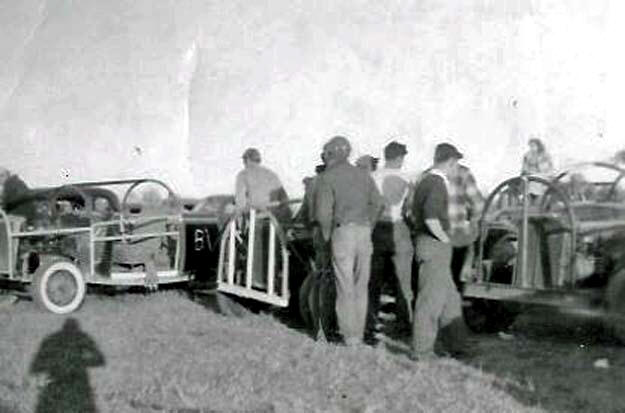
Courtesy of Bob Bearer via Bob Sharp
Vermont saw almost no
formal roadster racing. These beauties
were at one race at Fairmont Raceway in 1950. These jalopies
visited Fairmont from Champlain Speedway in New York. Below – Some of the
traditional stock cars in that time were almost as bad – like
this one at the jalopy track near Lyndonville.
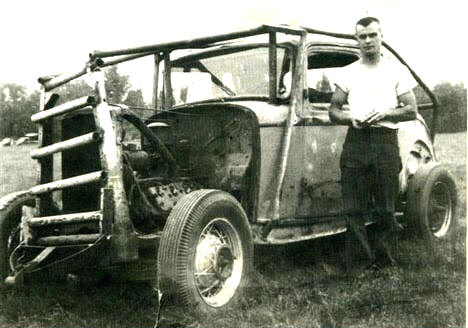
Northeastern Speedway Site Photo
For the uninitiated, roadster [which were very common in California, were stripped down early thirties cars with no roof and precious little safety equipment. Many roadster drivers held on with no seat belts or helmets. These cars \didn't weight much and could go like hell. Tracks for roadsters ranged from such venues as South Seneca, NY, McGregor Speedway near Saratoga Springs, Burden Lake Speedway near Troy, Champlain Speedway near Ticonderoga, and Perth Speedway nearer to Johnstown.
While one particular accident really set things in motion in New York, general malcontment fostered the attempts to ban racing in Vermont. I am certain that many New York communities, like Vermomnt's resented the noise, the disturbance of the sabbath, and all the rest; but, the death of Louis Willette really kicked everything over the edge. It served as a catalyst to go ahead and get rid of racing for all practical purposes. So we will handle New York first.
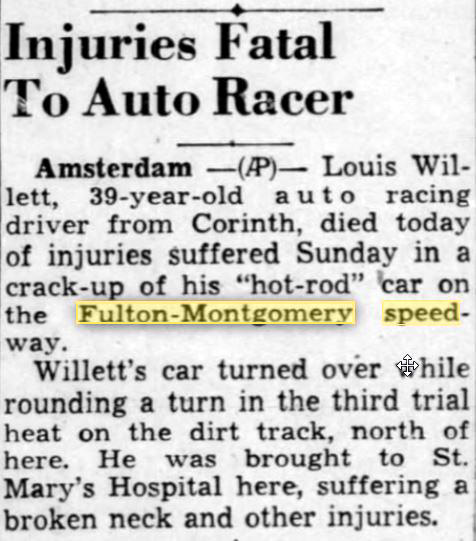
Ithaca Journal
The death of Louis Willette really set things off
in New York.
Below – In Vermont, this accident at Colchester Raceway had
the same effect.
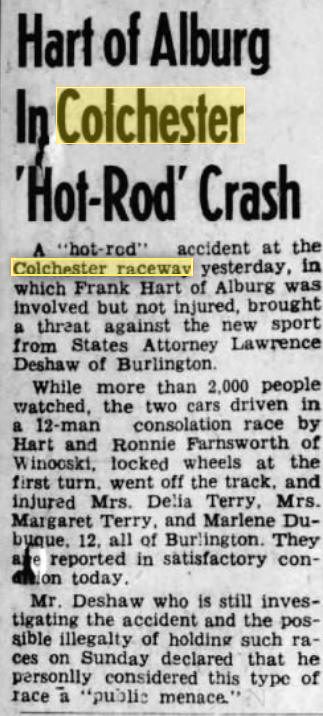
St. Albans Daily Messenger
Since right after the war, guys had been trying to race affordably [ the open wheel racing they saw at the fair was often too pricey]. So it came to pass that they would take old Fords, strip away roofs, fenders, and mostly any else they could, and proceed to race against one another. Places like Satan's Bowl of Death near Jamestown and Rudd's Beach in Colonie had seen pre – WWII racing of “jalopies” that could not even be dignified by calling it roadster racing. These things were often just what left of a chassis with a seat, steering wheel, and a motor. A few had a hoop of flimsy metal that wouldn't protected a flea if the car tipped over.
One of the better known earlier tracks is generally referred to as “Bob Whitebeck's Cinder Track”. Located in Canajoharie, the track [also called Canajoharie Motordrome] had some ungodly looking jalopies. Whitbeck, himself, would go on to be a hall of fame mechanic and car builder for seveal local stars – particularly when Fonda Speedway opened up in nearby Fonda. Also, an early roadster track opened for a year or so on the Henracle Farm near Fultonville, which was close to where the Whitbeck track had been. George Emden, track partner with Eric Duemler and Tex Hernacle, would later also drive stock cars at Fonda.
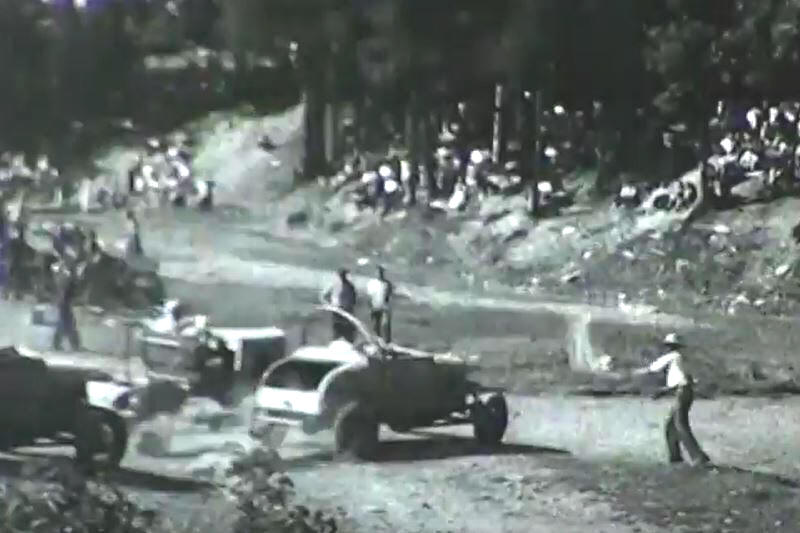
Source Unknown
This blurry 8MM frame capture shows
action at Satan's
Bowl o' Death in Busti, NY. How could anyone think this
stuff was dangerous ? Below – These beauties race at
the Old Rudd's Beach track in Colonie, NY. Both of these
photos are pre -WWII.
Source Unknown
So it was that after the war, men with mechanical talent or giant cahones would either build race cars, drive them, or both. Some of these early stars went on to race stock cars later, but many did not follow into the safer, roofed stock cars after the roadsters were eliminated. As mentioned, there were tracks toward the west such as South Seneca while the area near what would be the prestigious Fonda Speedway later saw four different tracks before the roadsters disappeared.
When Fonda and five other tracks throughout the Northeast experimente with a modified racing circuit in 1948, its first program included some support races by local roadsters [who were referred to there as “hot rods”]. Whitbeck was among the competitors in a race won by “Al Noakes” [which is widely considered to be racing name]. NASCAR's Ed Otto strongly disapproved of Fonda having anything to do with the roadsters – and they didn't return.

Bob Schwiekert Photo_Don Radbruch
Famed car builder Bob Whitbeck, as he
won a heat at
Fonda's 1948 program. Below - Art Pratt did a lot of his
racing in nothern New York at tracks like Tick Ridge,
Trout Lake, Warrensburgh and home town, Corinth.
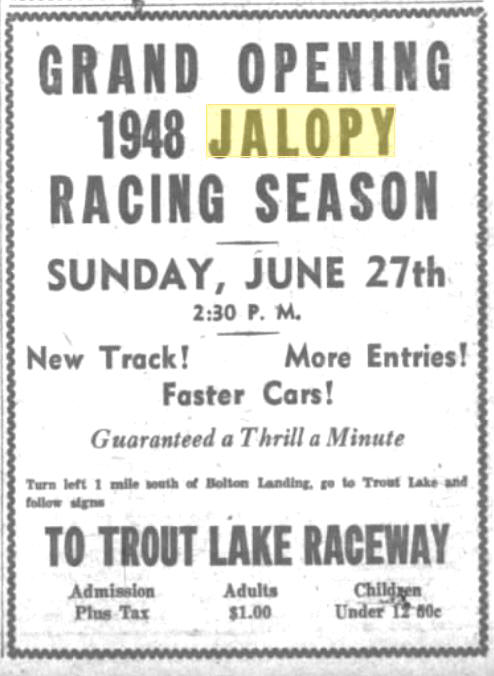
Glens Falls Post Star
There was an informal circuit of sorts, farther north, with Champlain Speedway, Ticonderoga; Warrensburgh Speedway, Warrensburgh; and Trout Lake Speedway near Bolton's Landing. Tracks were blossoming out all over the Empire State by 1948 and 49. The racing was annoying those aginst it all over the state.
There had also been a track near Corinth, NY, home of Art Pratt. Pratt was so good in the roadsters that he seldom lost and eventually was lured away to the Midwest and California to drive in the more organized open wheel cars such as AAA and USAC. To fill the absence of the big draw Pratt afforded promoters, his ace mechanic Louis Willette was talked into taking over Pratt's speedy car. Not too long after he took up driving, Willette was killed in a crash, leaving a wife and five kids behind.
Courtesy of Joan Swinton Walker
Champlain Speedway, in Ticonderoga was a key cog
in the roadster racing system, but was closed and
beginning to be under water by the NY racing ban.
Below – McGregor Speedway, in Wilton, protested
the ban and got it with both barrels, legally.
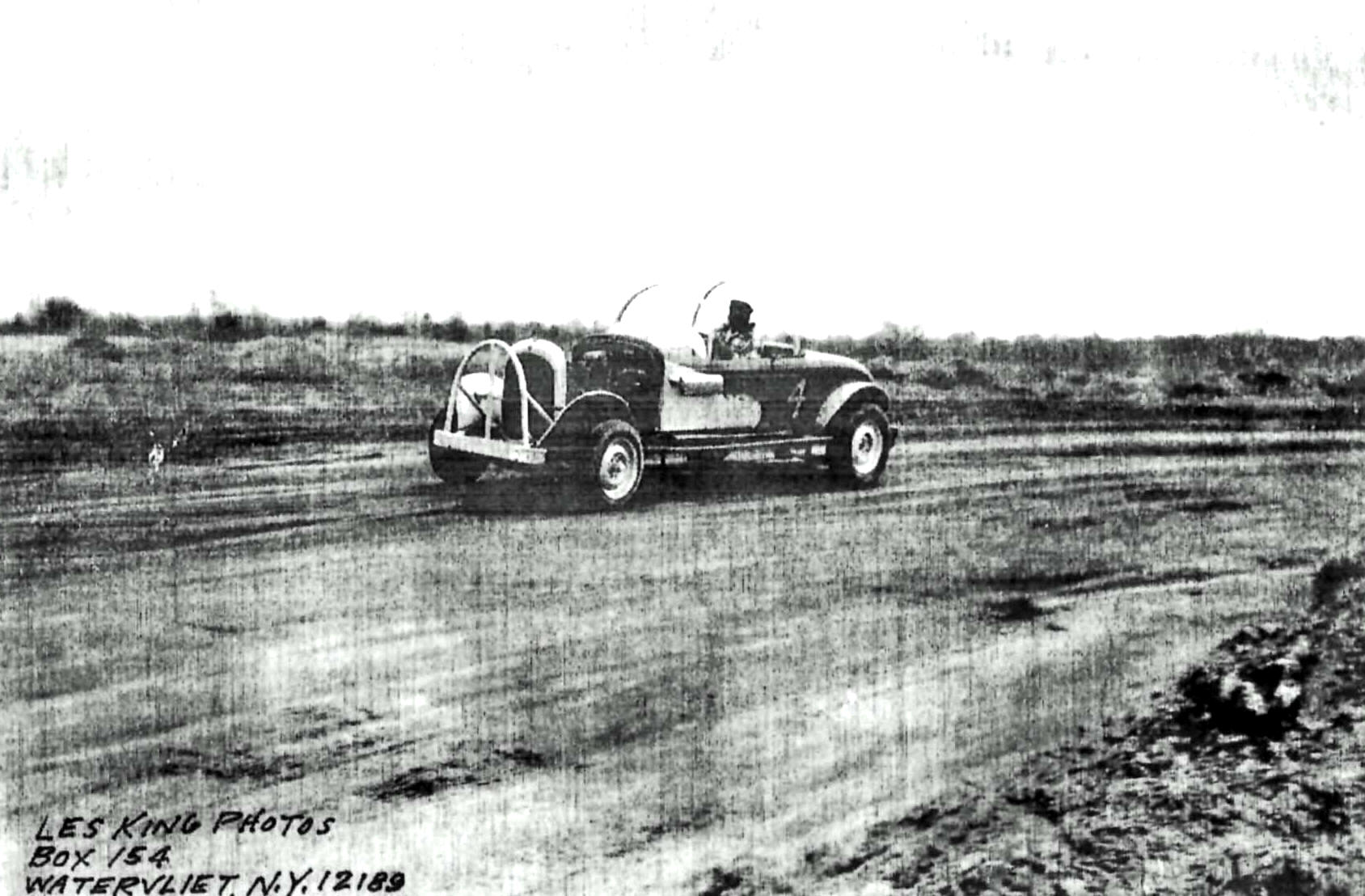
Les King Photo via Gail Moses Remington
This was too much for New York State authorites who were already besieged with complaints from all over the state. The New York State Police, armed with ancient Sunday Blue Laws that had been on the books since the 1800's descended on several tracks to shut them down. First, the roadster tracks were targetted; but later, many other tracks that ran on Sunday were also swarmed upon by legions of police.
Deputy Superintendent George M. Searles of the State Police said that Section 2145 of the State Penal Code prohibits public sporting events on the Sabbath, but baseball, football, hockey, and soccer are exempt from this ban. Armed with this mandate from Albany, NY, Searles led a huge campaign to shut down racing in his state. Racing folks railed at the unfairness: in a state where ideally a person could be cited for mowing his lawn on Sunday if it bothered a neighbor, other sports on Sunday were going on unaffected while racing was being stomped upon. The hammer first fell nearer to Albany – for obvious reasons.
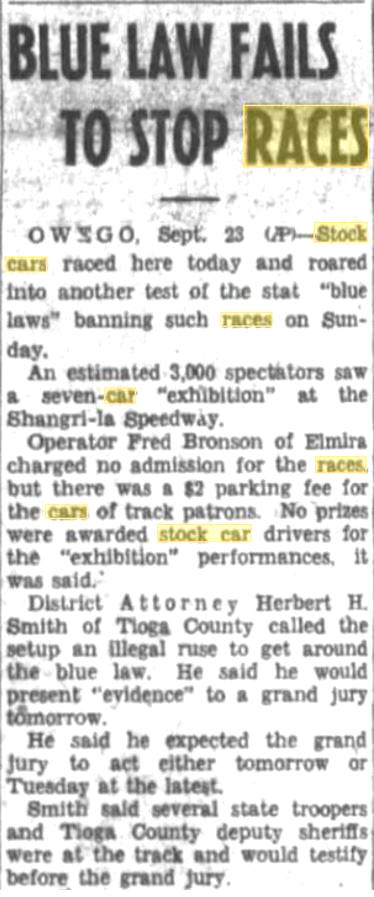
Glens Falls Post Star
Promoters in both states sought ways
around the sudden and
ridiculous brandishing of decades - old laws. Oswego promoter Bronson
charged no admission. Below – Vermont's State Line Speedway straddled
state lines; so, the track could start races in whichever state was ot
causing a problem at the time. The faint white line running vertically
through the faintly – evident track is the state line.
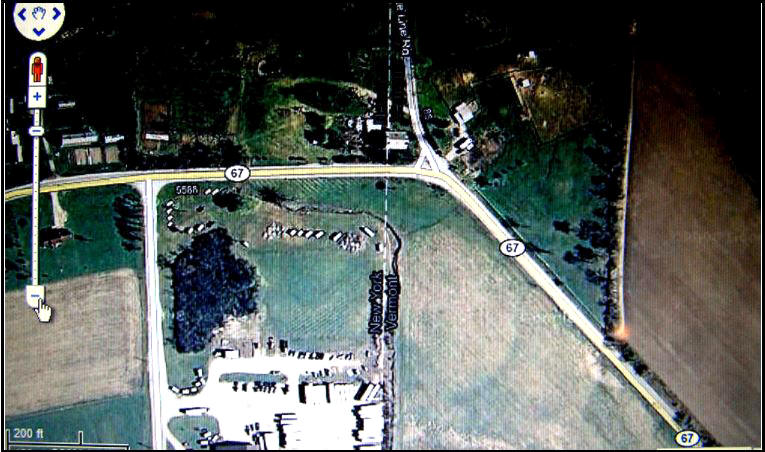
Google\ Earth
One article stated :”State Police at Troop G have invoked “an old state "blue law" to put a sudden halt to Sunday automobile races at more than a dozen speedways in Albany, Rensselaer, Greene and Columbia Counties.
The ban was announced last week by Kenneth Gray of Latham, who said "we are just enforcing a law that has been on the books for a long time."
Soon tracks all over the state were put on alert that there better not be any omore racing on Sunday. This placed them in a real bind because few, if any had lights and they had to run in the afternoon. If they went to Saturdays, there were running against larger, more established tracks. Some promoters and drivers tried defying the ban. They were summarily slapped down, in one way or another.
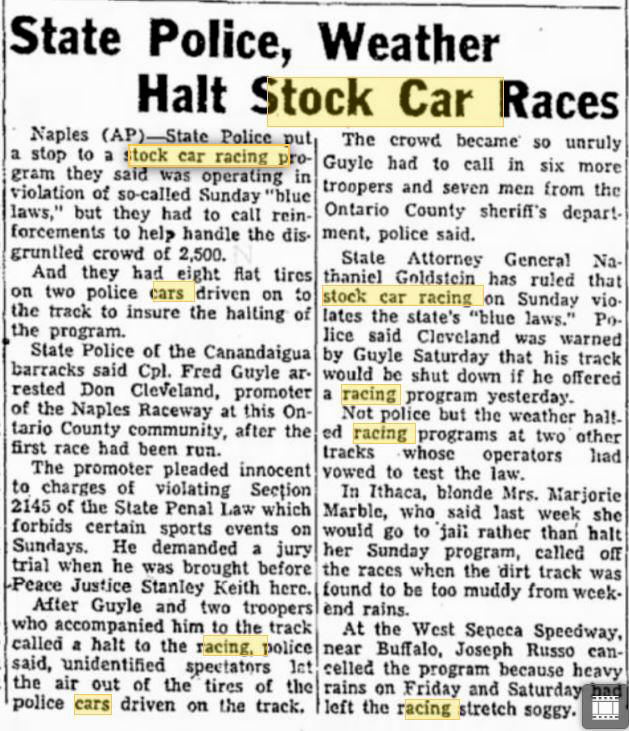
Troy Record
All hell broke loose when New York
moved on certain tracks
and not on others. Below – It happened in Vermont about a
year earlier.
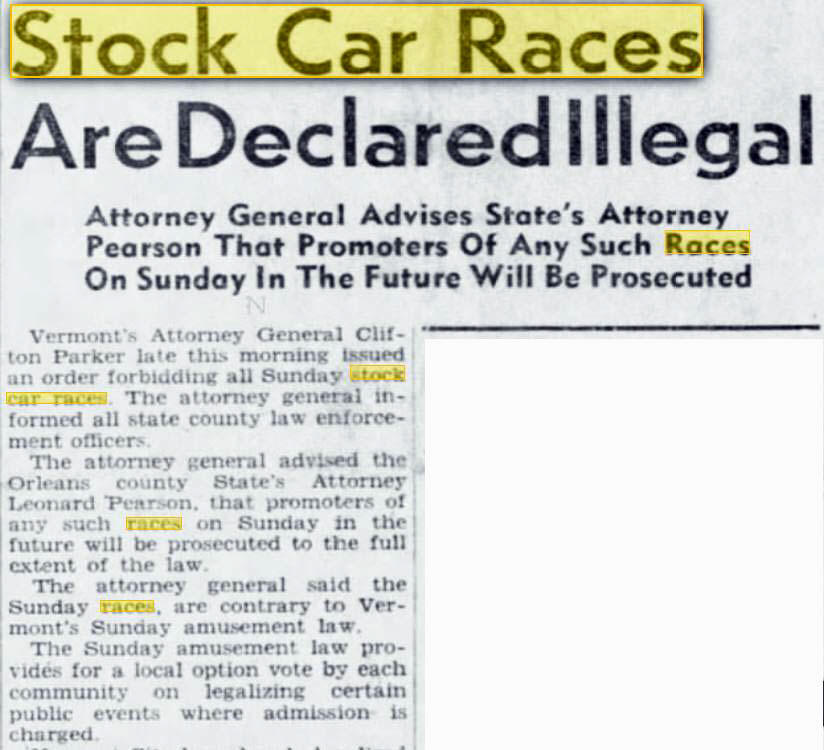
Newport Daily Express
Prominent NY racing historian Bob Miller wrote: “On June 23rd, 1951 - shit hit the fan. A unified effort between Donald Cleveland - promoter of the Naples Speedway (Naples, NY), Joe Russo - promoter of the West Seneca Speedway (near Buffalo), and the brand new track opening for the first time ever - The Ithaca Speedway (South Lansing) under the direction of female promoter Marjorie Marble - all agreed to stage races on the same day and at the same time with the specific purpose of contesting the state's blue laws.
At the West Seneca Speedway - State Police raided and seized the track before
Russo could sell a ticket. With nearby tracks already running Saturday racing,
he was eventually choked out of business. At the Naples Speedway - Donald
Cleveland and his ticket seller were both arrested after State Police stormed
the track while racing was being conducted, halting the show with police
cruisers blocking the speedway. Irate fans threw rocks and flattened police car
tires, necessitating a call of mutual aid for help from 7 Ontario County
Sheriffs Deputies and 6 more State Troopers to help restore peace.
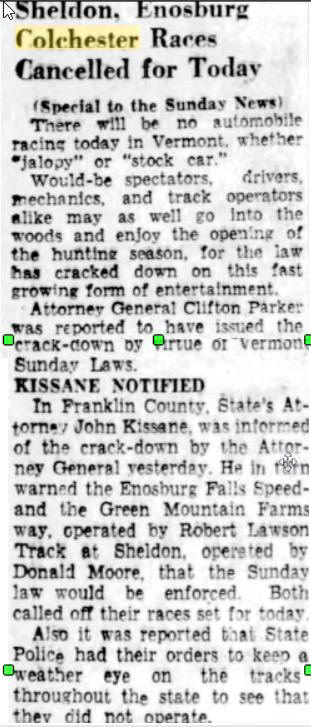
Vermont Sunday News
Just as in New York, the crackdown was swift and not
necessarily fair. For instance, while they targetted Smith's
Colchester Raceway, they ignored other tracks in the same
county that were less successful. Below -
The Ithaca Speedway never opened. Majorie Marble had originally said she would
promote from behind bars if necessary and would be the first female promoter to
do so, but was met with her 3rd consecutive rain out of her grand opener
instead. With an investment of $31,000 in personal funds, she decided to throw
in the towel as race promoter, saying she couldn't continue taking losses.
Ithaca Speedway never turned a competitive lap. “
Finally, by 1952, organized efforts were being made, through Albany, to rectify
the uneven way that the Blue Laws were being enforced. A Binghamton Press
article from 1952 headlined : Fairer 'Blue Laws' Sought for
State
It went on to say: “A
joint legislative committee was organized today for a fast study of how to
streamline New York State's Sunday "blue laws." The committee will submit
recommendations to the Legislature by Feb. 25 in an effort to remove glaring
Inconsistencies from the old laws, which permit some sports and recreational
activities on Sunday and ban others.
The article went on to add that most police officers were more and more
reluctant to enforce the blue laws. Some objected to ridiculous unfairness while
other were sick of being the targets of resentment. There had been some outright
riots at a few of the events they had moved in on. And yet others actually
wanted to be able to attend the racing as fans or compeeitors. Eventually, this
and other concerns signaled the end of the ridiculous Sunday Blue Laws.
Meanwhile, the the East, a similar thing had been happening – just on a smaller
scale. Vermont's racing ban problems seemed to be centered around Chittenden
County, the state's most populous – not Washington County near its legislature.
The Vermont racing ban seemed to stem less from the legistature and more from an
ambitious states attorney with an ax to grind.
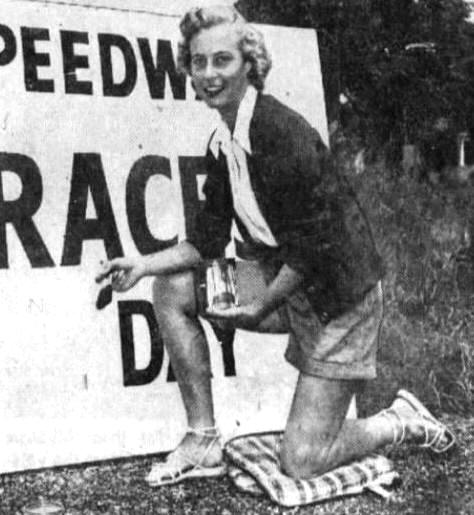
Binghamtom Press & Sun Bulletin
Charismatic Marjorie Marble went up against
the cops at Ithaca and came out on the losing
end. Below - This article speaks to
protests against how uneven was the enforcement of the
stock car ban in New York.
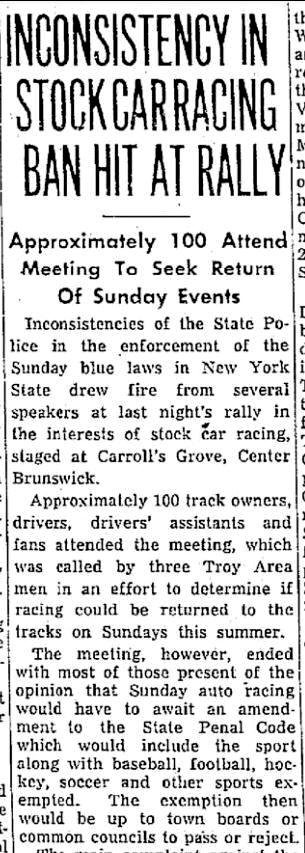
Troy Times Record
When the sh__ hit the fan in Vermont [as Bob Miller had put it], the tracks that
were hit hardest were those in Colchester. Chittenden County had almost six
tracks running at once- and five were in Colchester. Four of the tracks were not
successful enough to even bother with; that left Ivanhoe Smith's Colchester
Raceway and the Malletts Bay Raceway of Walter Barcomb. Smitty's track seemed to
get the worst because the fiesty French used car dealer from Winooski fought the
ban tooth and nail.
The thing in the Green Mountain State was that, unlike New York, they weren't
running roadsters or any sort of roofless jalopy. States Attorney Lawrence
Deshaw had taken on death at a race at the Champlain Exposition fairgrounds in
Essex Junction to go on his crusade to ban racing [and pad his resume for future
career improvement, I suspect]. That death, that of Arthur Bessette, was a case
of a drunken man who defied instructions to go home returning and running across
the track during the race -only to be struck and killed. It had little to do
with innate unsafeness there or anywhere else.
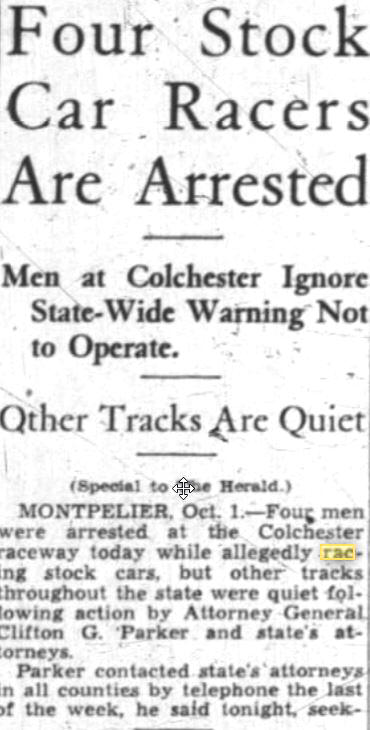
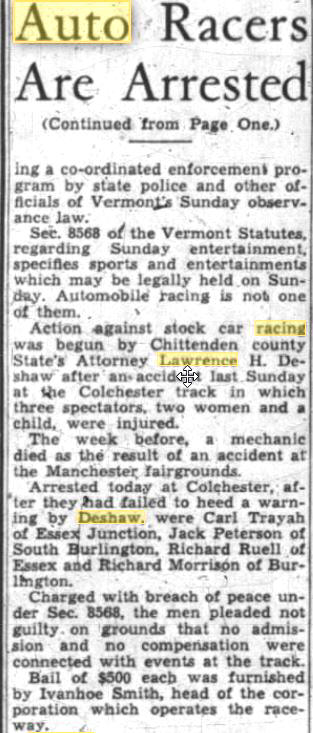
Rutland Daily Herald
“The
Colchester Four” had their names appear in a staggering
number of newspapers all the nation. Peterson and Trayah wnet
right on racing, both winning state championship races soon
after the heat died down. Below - The flamboyant and unfortunate
promoter Ivanhoe Smith [shown at right in the only photo there is ]
survived the showdown with Deshaw in 1950 only to be sued later as a
partner in Colchester – Bayview Speedway over a death at a race they put
on at the local fairgrounds a year later.
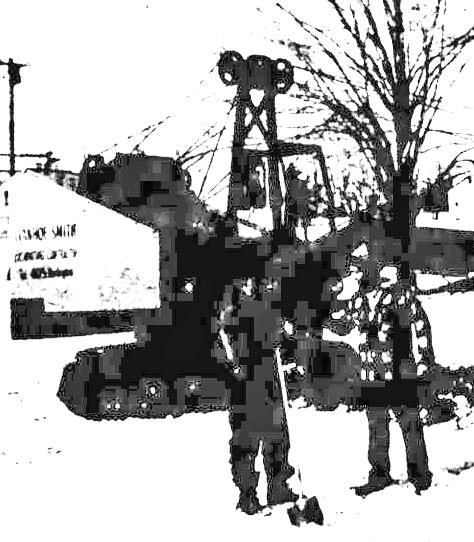
Burlington Free Press
There is not much on what
happened with Barcomb's track – which ended up being the longest – lasting and
best – known Colchester track. Smitty, on the other hand, saw the ban as an
affront. He immediately scheduled a Sunday race and proceeded to stage it fans
and all. He got well – known local racers Jackie Peterson and Ron “Rollover”
Farnsworth to show up along with “some c ollege kid” who had a race car at the
time.
They were all hauled off to the county jail and the fans were sent packing,
cursing and sputtering all the way. Viola Trayah, sister of the racing Trayah
brothers [Carl and Herb] was particularly hard to dislodge seeing as she could
beat any man in fist fight. They were called “tin star 1&%#!'s” and a few other
choice terms. Once out himself, Smith was true to his drivers, bailing them out
and taking them out for a beer. This was enough for the collegian who soon sold
his car to Peterson.
Unlike New York, the flap did
not spread throughout the state, and the whole thing sort of died down in
Chittenden County afte a while. I don't know how this affected the career of
Deshaw. I realized I had gone to college with his son, Lawrence, Jr. If I had
known what I know now, I would have quizzed him about what he knew; he would
have been about six or seven years of age at the time.
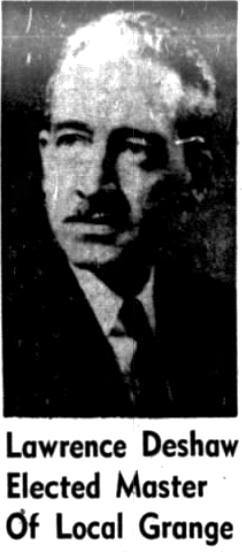
Burlington Free Press
By the mid 1950's, particularly
in Vermont, it didn't matter much any more. A vast majority of the 20+ tracks
that existed in 1951 were gone. Many of the more familiar tracks had not even
been built or started by then. Racing was still going on at Stateline Speedway,
near Bennington. The track which sat both in New York and Vermont could have
gotten from both sides but the promoter, Mike Akhoury cooly assured officials
that, when harrassed by NY, he'd start his races in Vermont and vice versa.
Walter Barcomb's track. Like
Stateline, lasted until around 1959. The short – lived but really
organized Northeastern Speedway began that year but was effectively killed by
the establishment of Thunder Road in 1960. New York State would try it again in
1951, with results about as resounding as what happened in
Vermont. Again, the ban managed to end the lives of a number of tracks but, in
the end stock car racing still goes on to this day.
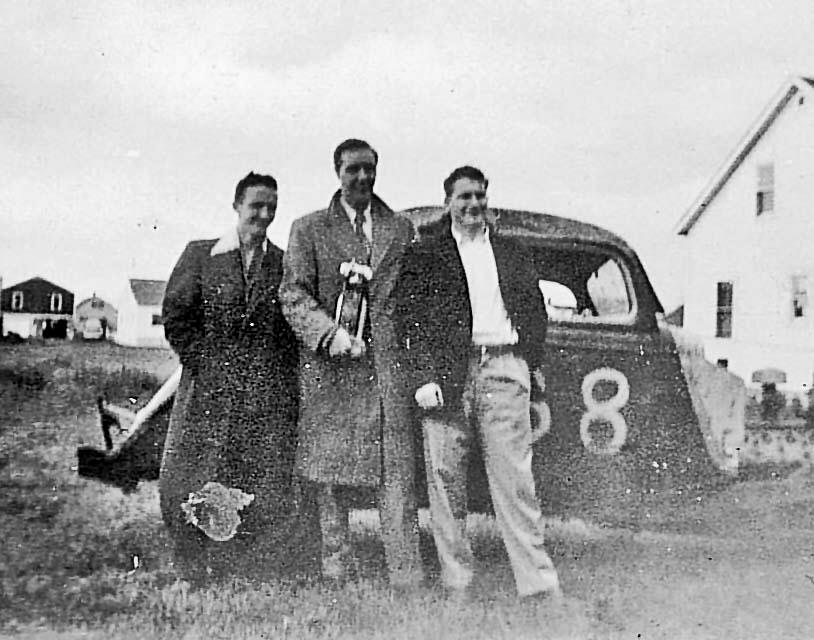
Peterson Collection
Jackie Peterson [ctr with two car owners] is the only surviving person from the
great
1950 flap at Colchester Raceway, He obviously
overcame being jailed and bailed as
he poses with his 1950 Vermont State Championship
trophy later that year.
Please email me at wladabou@comcast.net if you have any photos to lend me or information and corrections I could benefit from. Please do not submit anything you are not willing to allow me to use on my website - and thanks. For those who still don’t like computers - my regular address is: Bill Ladabouche, 23 York Street, Swanton, Vermont 05488.
AS ALWAYS, DON’T FORGET TO CHECK OUT THE
REST OF MY WEBSITE:
www.catamountstadium.com
Return to the Main Page
Return to the Main News Page
Return to the All Links Page
Return to the Weekly Blog Links Page